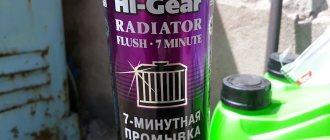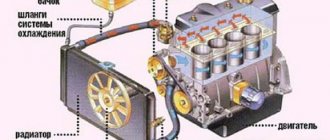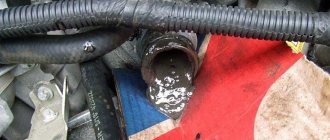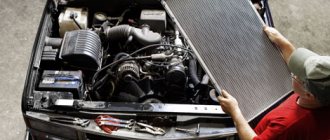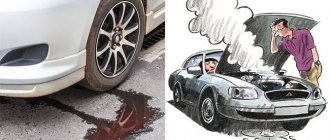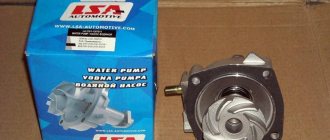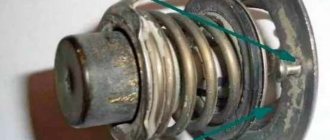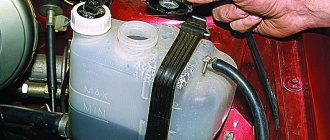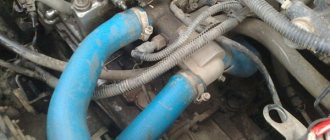Yesterday (June 21, 2015) we started flushing/cleaning the engine cooling systems of two cars: my Priora and my girlfriend’s Matiz.
MATIZ
First we tackled the green Matiz. Used car 2007. It is very likely that the antifreeze has never been changed. The antifreeze was foam, which motivated specific cleaning and replacement. The job was done in a garage without overpasses. There are not so many pictures, because the business is busy, there is no time to be distracted. But we followed the principle: 1) Unscrew the radiator, remove the pipes, and take out the radiator. And separately from the car, we rinsed the inside of the radiator several times to remove foam with tap water until it was in a normal state. The expansion tank is the same. 2) Having opened the stove, start the car and pour a stream of water into the tank to rinse the pipes, again, at least from foam. We washed it and turned it off. After this, you can even blow into the tank so that the remaining water comes out as much as possible. You can see how it is blown in the video.
3) Next, put the radiator in place and connect all the pipes. 4) The next stage is “Acidified water”. We took tap water again. Mixed about 5 liters of water and 160 ml of 70% acetic acid
. We poured the mixture into the tank and started the engine. We ran the engine at idle in our Sunday heat (+30), the fan turned on, after turning it off we turned it off. 5) Next, remove the pipes again and pour boiling water wherever it is more convenient for someone. We remove the radiator and wash it. Let's put everything in its place. 6) Now it’s time to use pure distilled water. Approximately 5 liters inside and again run the engine for 10-15 minutes. 7) Drain, blow, put everything in place. End. Fill the new purchased antifreeze with about 4-5 liters. Ride for your health.
PRIORA
Priora was driven onto an overpass. The radiator was not removed. I had antifreeze in my system. I decided to rinse the SOD and change the antifreeze to G12 antifreeze. 1) We expel the antifreeze through the plug at the bottom of the radiator. And through the drain hole in the engine (13 bolt).
2) We do it in the same way as the Matiz: wash the tank, rinse the pipes from the inside, and blow them out. 3) Assemble the system, fill in a mixture of about 7 liters of water + 200 ml of acetic acid
. We run the engine for 10-15 minutes. 4) Drain thoroughly, expel the water, and blow through. 5) Run in distilled water for 10-15 minutes. Pour it out and blow it out. 6) Fill in red antifreeze G12 approximately 7-8 liters to the mark. And also, just in case, I changed the cap of the expansion tank. 7) After the race, top up if necessary. The exercise is finished.
Costs for Priora: 1) 2x5kg Antifreeze G12 Sibiria = 2×339r = 678r
.
2) Original tank lid 85r
.
3) 1 bottle of acetic acid = 18 rubles
. 4) Distilled water = by pull.
The internal combustion engine is exposed to high temperatures during operation. The design of the internal combustion engine includes a cooling system (OS). The principle of operation is the circulation of liquid in the radiator and pipelines. During prolonged operation, blockages form on the walls of the cooling system in the form of salt deposits, oxidative sediment and dirt accumulations. Clogging of the radiator channels and process pipes leads to overheating and premature wear of the piston group.
Flushing the engine cooling system is an important regular procedure required during maintenance. Controlling the volume of antifreeze in the system (maintaining an average level in the expansion tank) and cleaning the technological channels with special means will ensure optimal temperature and long-term operation of the internal combustion engine.
Be sure to read the article by our specialist, which talks about which is better - antifreeze or antifreeze.
You can find more detailed information on how to properly dilute antifreeze concentrate in our expert’s material.
When is it necessary to flush the engine cooling system?
Contamination of the technical channels of the internal combustion engine is indicated by the constant operation of the fan on the cooling radiator and malfunctions of the heating system. The problem must be resolved as soon as possible. You can do this yourself.
A number of signs indicate the need to flush the engine cooling system:
- regular overheating and problems with subsequent startup of the power unit;
- slow response to the rheostat signal;
- high readings of the coolant temperature sensor after starting the engine;
- pump operation with constant interruptions;
- change in the color of the coolant in the tank.
If such symptoms occur, it is necessary to immediately change the fluid for flushing the engine cooling system.
Causes of clogged engine cooling system
The working coolant has a tendency to “boil over”. Antifreeze, distilled water or antifreeze circulates in the system - these are working coolers, which are monitored by marks in the tank and periodically topped up. Overheating and boiling over leads to loss of coolant properties and the formation of deposits in pipelines and on the internal walls of the radiator.
You can learn how to replace the coolant from our specialist’s detailed material.
We recommend that you additionally read our expert’s article, in which he talks about how to remove air from the engine cooling system.
Possible causes of clogging:
- dust and mechanical inclusions;
- chemical deposits;
- formation of salts (when adding regular water);
- corrosion of the material of the internal elements of CO with precipitation into a clogging sediment.
Changes in color and smell are signals to replace the distillate. If the consistency changes, foreign particles appear, or a contaminated emulsion forms, you must immediately use means to flush the engine cooling system.
Where does scale and deposits come from in the cooling system?
As you know, antifreeze does not form scale, however, if you do not completely replace it, but constantly add it, then over time its concentration will consist of more than half of water, and the additives that are included in its composition will begin to disintegrate, depositing on the walls thick layer of plaque. Read above about what happens next. Dust, oil, dirt, rubber waste and rust also contribute to contamination and can create a blockage in the cooling system or simply deposit as deposits on the walls.
General rules
A gentle flush of the engine cooling system can be done with distilled water. To remove scale from the walls of pipelines, special solutions will be required.
The car is placed on the site. The process begins by draining the old coolant. Special drain plugs are unscrewed at the bottom of the radiator and on the cylinder block. Used antifreeze or antifreeze is poured into a previously placed container.
The system is washed with distilled water or a weak special solution. To prepare you will need one of the components:
- soda;
- vinegar;
- citric or lactic acid.
Sometimes Coca-Cola is used, but you should be careful about this process. “Cola” has an aggressive effect on the internal walls of the radiator.
You will need to start the engine and run the fluid for about 10 minutes. Upon completion of the process, you need to rinse the OS with distilled water, and then add new antifreeze or antifreeze.
Flushing with home remedies
Preventative work to remove scale and dirt is carried out every 6-12 months. In Soviet times, technical channels were regularly cleaned with “acidified” water. Baking soda, citric acid and vinegar were used. The solution was made in small concentrations so that the inner walls would not oxidize in an aggressive environment. The work was carried out carefully, taking into account the contamination of the canals. Such methods remain relevant today, and the process demonstrates the desired effect.
If you do not flush the cooling system, you may encounter unpleasant problems:
- breakdown of the distillate heater;
- unstable operation of the heating stove;
- water pump blockage.
To avoid disastrous consequences, you need to figure out how to flush the car’s cooling system. Modern cleaning methods at large service stations are based on the use of special expensive compounds. Their range of use is designed to remove all possible contaminants and allows you to get rid of organic deposits and rust.
Additives are produced on the basis of two-component compositions. There are neutral options consisting of an acidic or alkaline solution. Additives provide a targeted action to eliminate a specific type of contamination.
Rinsing with distilled water
After draining the old coolant, the system is filled with distilled water.
- close the valves on the radiator and cylinder block;
- start the car;
- keep the engine idling for up to 20 minutes;
- wait for cooling and repeat the procedure.
Washing is considered complete when the distillate at the outlet is cleared of foreign inclusions. This method allows you to wash out accumulated dirt, but will not clear the channels and internal surfaces of deposits.
How to flush the engine cooling system with citric acid
It is necessary to prepare a concentrated solution. The calculation is made in the optimal proportion - 200 grams of citric acid per 10 liters of boiled water. The composition is poured into the expansion tank until the system is completely filled, but not above the maximum level.
The coolant temperature is monitored by a sensor. The scale decomposition reaction is effective at a temperature of 80 degrees. After the engine has cooled, repeat the process with a lower concentration of solution (100 g per 10 liters of water). The next flushing is carried out with clean water, and then antifreeze or antifreeze is added.
Washing with acetic acid
The procedure is also effective with 9% table vinegar. A 0.5 liter bottle is dissolved in a bucket of boiled water. The procedure consists of the following steps:
- warm up the engine for about 30 minutes;
- leave the charged system for at least 8 hours or overnight;
- drain the used liquid and rinse with distillate.
Whey wash
The option with lactic acid or whey is an effective way to clean OS. The car will need to run in active mode (at medium engine speeds) for about half an hour or drive 40-50 km without stopping.
How to rinse SOD?
- Water.
- Water with vinegar and acid.
- Special liquid for flushing the cooling system.
Flushing the cooling system with water
Although it is possible to flush the system with water, I would strongly advise against it. As I already said, it contains a large amount of impurities and salts that form scale. If there is no other option, then at least use distilled water. Flushing the cooling system using distilled water is done as follows:
- Pour water into the SOD.
- Start the engine and let it run for about half an hour.
- Then turn off the engine and drain the water from the system. Repeat the procedure until your flushing fluid is the same as before flushing. The disadvantages of this method include: scale formation, low efficiency (boiling water is not able to dissolve and wash scale and other deposits).
Flushing the cooling system with water, acid and vinegar
Water with vinegar and acid is a little better than just water, because thanks to acids you can remove scale and partially clean the cooling system. In order to flush the system using this method, prepare: caustic soda, lactic acid and vinegar. The acid is added carefully and a little at a time; if you overdo it, you can say goodbye to the plastic and rubber parts of the cooling system. To completely remove scale and dirt, it takes 5-10 hours, during which it is necessary to periodically warm up the engine to operating temperature. At the end, all the liquid is drained and distillate is poured in, which is used for the final flushing of the cooling system.
Washing SOD using special chemicals
Specialist. means are the most effective and expensive option. However, the effectiveness of such a procedure is worth the overpayment. Cleaning products contain special cleaning agents that actively remove scale, grease, organic matter, etc.
Flushing specials products are divided into four types: acidic, alkaline, two-component, neutral.
Acid and alkaline are considered the least popular; moreover, they are almost impossible to find undiluted. This is explained by their aggressive effect on the entire cooling system, essentially plastic and rubber products.
Two-component products are very popular and in great demand. Their 2-component solution consisting of alkali and acid copes well with the task. Each of the components is poured into the radiator in turn.
Neutral cooling system cleaning products contain aggressive substances, such as acids or alkalis, and are used exclusively for preventive purposes.
Summing up
As you can see, there are quite a few ways and means to clean the cooling system and each of them has its own characteristics. If you do not want to spend money on expensive cleaning products, follow basic rules that will prevent the formation of plaque and scale. Namely:
- Fill only with high-quality antifreeze.
- Monitor its condition regularly and replace it on time.
- From time to time, wash the SOD using special. facilities.
That's all for me, thank you all for your attention and for visiting our
Why flush the cooling system?
Antifreeze gradually accumulates deposits that impair the performance of the engine cooling system.
The cooling system of the VAZ-2110 works in hellish conditions . You can’t envy her, because in addition to antifreezes of dubious quality that litter the shelves (such as “antifreeze” in a beautiful blue color), the cooling system is badly affected by banal dust and dirt. There is plenty of this stuff on our roads. It is external contamination of the radiator, cylinder block, and heater radiator that often causes overheating.
And where there is overheating, there is the release of sediment and clots by antifreeze.
Danger
Cloudy liquid in the expansion tank indicates significant contamination of the engine cooling system.
All this settles not only on the wall of the water jacket, but also in the honeycombs of both radiators - the stove and the cooling radiator. After several years of such operation, the engine may overheat even in cold weather under light load. The thermal conductivity of radiators and cylinder block walls is rapidly falling, and the temperature gauge needle is stubbornly creeping up.
Consequences
To avoid consequences, at least occasionally inspect the condition of the cooling system visually. You can start by inspecting the coolant reservoir.
How and with what to flush the cooling system on a VAZ-2110
Many people start flushing the system by draining the old antifreeze. In vain, because first of all it is necessary to keep the radiator and engine clean.
Mechanical cleaning of the radiator.
If the radiator honeycombs are clogged from the outside with dirt, leaves, flies and winter road fill, there can be no talk of any cooling. The same applies to the cylinder block and engine head. Some engines are difficult to see from under a layer of dirt and oil mixture that covers the entire engine. Naturally, the heat transfer of such engines suffers greatly.
That is why, first of all, it is worth thoroughly flushing the engine and radiator outside. It is advisable to use any detergents and water under reasonable pressure for this. It is better not to get too excited with pressure, since strong pressure can damage the radiator honeycombs. There are special means for externally flushing the radiator, but practice shows that they differ from dishwashing detergents only by being overpriced.
Will folk remedies help?
Folk remedies for flushing can be quite effective, but use them at your own peril and risk.
But to flush the system from the inside, folk remedies are not enough. No Coca-Cola or other nasty stuff is good for this.
All this can only make the situation worse. It is also unacceptable to flush the system with well water or tap water - this water is too hard, which implies a huge amount of salts and minerals. They will definitely settle on the walls of the water jacket and radiator honeycombs from the inside and will completely ruin the cooling system, although after draining plain water it may look perfectly clean, causing the illusion of a sterile system.
Chemistry comes to the rescue!
The inside of the system is washed only with special products, which are abundant in stores and are inexpensive compared to a new radiator. All these means are aimed at decomposing and removing organic fats and mineral scale, which is what clogs the system the most. In general terms, all flushes are divided into several types:
- Alkaline washings are inexpensive but ineffective means, although with a low degree of contamination they can bring a positive result.
- Two-component washes . When using them, you must strictly adhere to the instructions; they are poured in a certain sequence; after each cycle, the system is washed with distilled water. The result is very good.
The two-component set consists of an acid and an alkaline wash.
“Soft” flushing is suitable if the antifreeze is changed regularly and there are no signs of contamination of the cooling system.
It is important to remember that different types of washes should never be mixed.
This can lead to the formation of new clots, and in the best case, the effect of the drugs will be mutually compensated and the result will be zero. The key rule when using rinsing is to strictly follow the instructions for the liquid and use it in combination only with good quality distilled water.
There are two types of SOD purification:
External - when insects, dust, oily stains, dirt and other nasty things are removed from the surface of the radiator. Typically, this cleaning is done using a jet and car shampoo.
Dirty radiator - poor cooling
Internal - provides for the removal of deposits consisting of rust, scale, antifreeze decomposition products and rubber parts from the engine cooling jacket and radiator. In addition, contamination and scale are possible in cases where the car owner uses ordinary tap water as coolant. This should not be done under any circumstances, since such water contains a huge amount of salts, impurities and various substances, which, when heated, are deposited on the walls of the cooling system in the form of plaque, complicating heat transfer and reducing the cross-section of the SOD passages.
We flush the cooling system with our own hands
It is advisable to carry out washing at least once a year. This is guaranteed to save us from problems with engine overheating.
We change old antifreeze of unknown color without hesitation.
Naturally, it is advisable to replace the antifreeze during the washing process. However, if the antifreeze is fresh and clean, this is not necessary. In this case, when draining the liquid, place clean containers under the radiator tap and the cylinder block plug.
- After draining the antifreeze, tighten the drain valves and plugs in accordance with the flushing manufacturer’s recommendations, fill the system with the mixture and warm up the engine to operating temperature or wait until the radiator fan turns on.
- We drain the flush and assess its condition.
If after the first time a cloudy liquid comes out of the system, repeat the process with a new portion of flushing.
We finish this “water procedure” when clear water flows.
Fill with antifreeze and tighten the reservoir cap.
When the engine has cooled down, check the antifreeze level in the expansion tank.
Replacing antifreeze on Lada Priora and cleaning the cooling system
Coolant (antifreeze), designed to lower the temperature of an engine that heats up during operation, needs to be replaced, like any other operating fluid. In a Lada Priora car, it indicates the need to replace antifreeze every 75,000 kilometers or once every five years (whichever happens first).
You should replace the coolant in a timely manner - otherwise you risk the fact that the additives added to the antifreeze may wear out and fall out as deposits that settle on the metal elements of the engine and the cooling path. They are aggressive towards the parts described above, accelerating their wear. In addition, in this case, there is a possibility of encountering overheating of the coolant, which entails a loss of power, increased fuel consumption and a reduction in engine life by 2-3 times. This occurs due to the formation of corrosion on the internal surfaces of the engine, narrowing of the radiator channels (and, therefore, a decrease in the coolant circulation rate). And continuous operation of the engine in overheating mode leads to deformation of the cylinder oil scraper rings, which entails mixing of exhaust gases and oil.
In addition, cavitation erosion (bubbles in the coolant) and the formation of silicate sediment are possible. In winter, a worn-out cooling system can contribute to the formation of cracks in the expansion tank.
As you can see, untimely replacement of antifreeze leads to serious wear of both the entire cooling system and engine elements. Therefore, you should periodically monitor the coolant level and check it. If you unscrew the reservoir cap and see that the antifreeze has faded, lost color or become cloudy brownish, you should replace it as soon as possible.
A more or less decent auto repair shop will charge you at least 800 rubles for replacing antifreeze. (prices from an official dealer are even higher). Not all services clean the cooling system; on average, the cost of this procedure ranges from 1,300 to 2,500 rubles. You can save a lot of money by replacing and cleaning it yourself. This will not require extra effort, and you will gain good experience.
Also, do not forget to purchase a new antifreeze canister (about 1,200 rubles for a 5-liter canister) and an expansion tank cap (its price is around 100 rubles).
The following equipment and materials will be required:
- Actually, antifreeze (8 liters)
- Screwdriver (preferably Phillips)
- Wide funnel attached to hose
- Distilled water (15 liters)
- Bottle brush
- Key diameter 13 mm.
- Citric acid or similar cleanser (2 sachets)
- Expansion tank cap
- Bucket or other container (volume of at least 8 liters), preferably 2 pcs.
We collect everything you need nearby so that it is at hand:
Next, you need to put the car in the pit, then open the hood. The antifreeze will cool down for some time, so you should wait a little:
After this, it is necessary to remove the engine crankcase protection. Without performing this procedure, it is possible to remove spent coolant from the radiator cavity, but not from the BC.
First, place a container for old antifreeze under the drain hole.
Important: there is no need to unscrew the cap of the expansion tank, otherwise antifreeze will violently begin to pour out around the sides.
Unscrew the bolt plug of the drain hole on the BC, drain the waste liquid into a container:
If, after unscrewing the drain cap, antifreeze does not flow out, then a plug of dirt has formed near the drain hole, which can simply be loosened with a screwdriver.
Then you need to unscrew the cap of the expansion tank (this is necessary to equalize the pressure). Then you will need to drain the antifreeze from the radiator. To avoid accidentally hitting the generator, you can wrap it in a plastic bag or wrap it in a rag.
We find the valve, which is located at the bottom of the radiator, on the right, in front of the radiator. We place an empty container under this valve.
The valve should be unscrewed carefully, as the pressure of the coolant can be strong:
The more antifreeze is poured out, the more the valve should be unscrewed. Attention: there is a rubber seal on the valve, it is important not to lose it.
As soon as antifreeze stops flowing from both drain holes, you will need to screw the drain plug on the cylinder block and tighten the radiator valve.
It is necessary to pay attention to the color of the waste liquid. If it is not very cloudy, the cooling system can be cleaned using only distilled water. If there are various floating substances, etc., in the coolant, you will need to add citric acid (1 sachet) to distilled water.
Before you begin cleaning the cooling system, you will need to remove any air pockets in the circuit.
To do this, you will need to remove the hose from the heating fitting of the throttle assembly:
Only after this can you pour water diluted with acid into the removed pipe using a pre-prepared hose with a funnel. As soon as water begins to flow from the removed pipe, stop adding coolant. Do not close the expansion tank cap yet.
Then you will need to insert the hose into the fitting and start the engine (with the neck of the expansion tank open - this is required to better clean the circuit from air pockets). Wait 5-10 minutes, then turn off the engine. After this, you will need to drain the water using the method described above.
If the used cleaning fluid does not contain suspended matter or other substances, you can begin cleaning the expansion tank. If any sediment or impurities are clearly visible in the liquid, repeat the cleaning procedure with distilled water and acid again.
Don't forget to put the drain plug back in place:
Thanks for subscribing!
Using the vehicle’s operating and maintenance instructions, remove the coolant reservoir and inspect it for damage:
If no cracks are found, the tank should be washed and thoroughly cleaned with a brush.
If the tank is cracked, it must be replaced with a new one:
In accordance with the instructions, we install a new tank instead of the old one, and then fill the antifreeze to about halfway (between the MIN and MAX marks):
After this, you will need to screw on the new expansion tank cap, then start the engine and let it run for 5-10 minutes. If during this time no smudges or leaks are clearly detected under the hood, most likely all of the above operations were performed correctly.
However, to be more sure, you can do the following.
You will need to wrap paper napkins around the connections described above (pipes, etc.):
Then you need to drive the car for some time, and the next day you will need to check the condition of the napkins. If no leaks or smudges are detected overnight, it means that everything was done correctly and the procedure for replacing antifreeze and cleaning the cooling system in a Lada Priora car can be considered complete.
